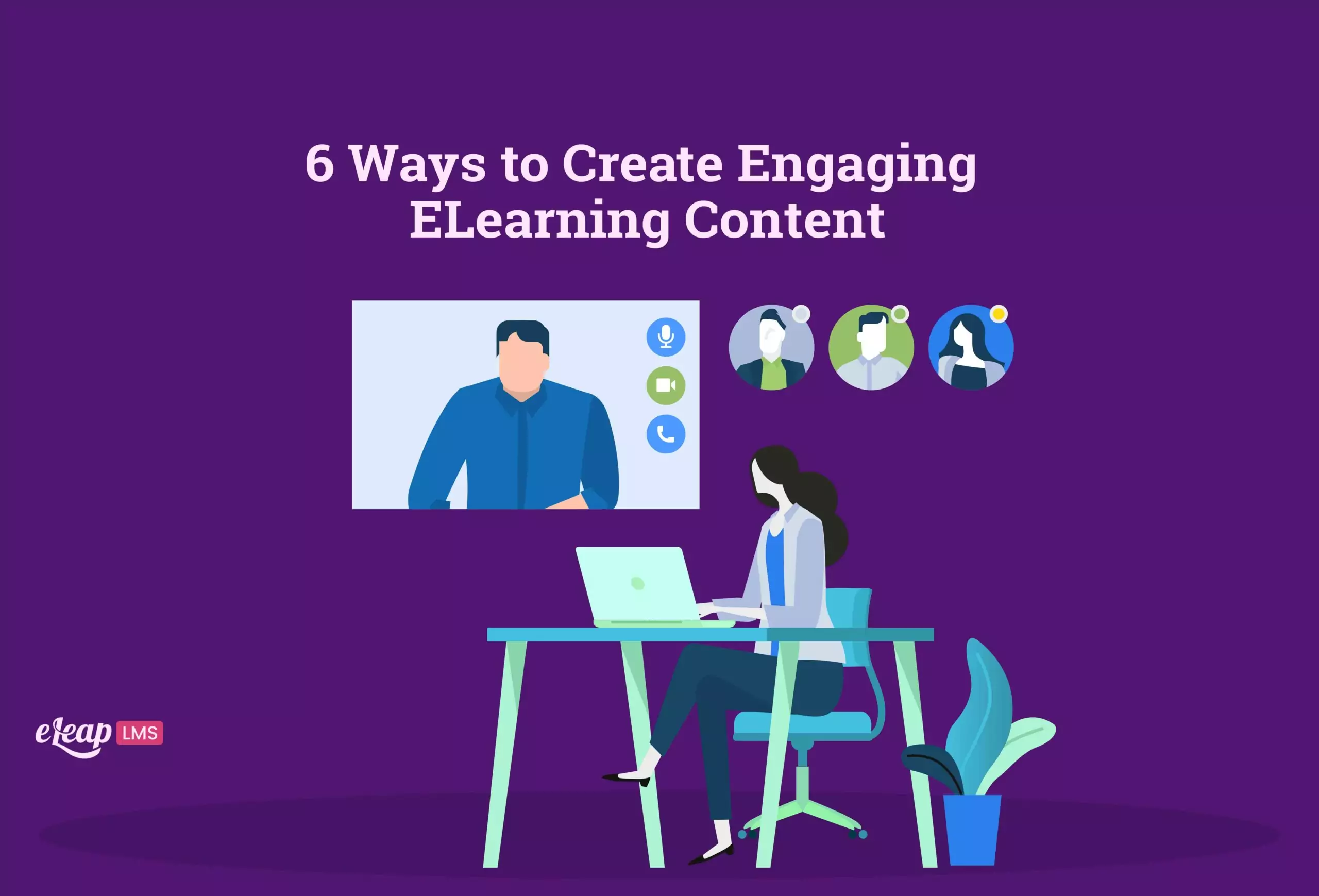6 Ways to Create Engaging ELearning Content

In a world where technology has revolutionized the way we learn, creating engaging eLearning content has become an art. It’s no longer enough to present information in a dull and uninspired way. Today’s learners demand interactive and dynamic experiences that keep them engaged and motivated. But with so many options available, where do you start?
In this blog, we’ll explore 6 proven strategies for crafting eLearning courses that captivate your audience and drive results. So, let’s dive in and discover the secrets to creating eLearning content that is both educational and enjoyable!
How To Create Engaging eLearning Content
Below are some valuable tips you need to create engaging eLearning content:
Understand The Purpose Of Your Content And Discover Your Learners
You can’t give what you don’t have! Before developing content for eLearners, you must spend time exploring the aim of your course. As the developer, if the aim isn’t clear to you, it won’t be clear to your audience.
Your targeted audience should understand why your course is necessary for them to take and the value it brings to them. Once your audience knows this, investing their time and resources into your content will not be a struggle.
You must understand your audience’s needs by researching them. You need to know the type of content they prefer and their learning style. This will then determine what your course will be about and how it can be best presented.
Make Your Content Relevant

Adding unnecessary information to your content will make your audience wonder about its relevance and authenticity. Therefore, you must make your course relevant from beginning to end.
You can utilize the art of microlearning in your content. Microlearning caters to gaining knowledge daily in absorbable chunks, such that the course covers only pertinent and updated information. According to research by Forbes, microlearning can boost understanding by 17%. Besides, filling up your content with irrelevant and outdated information will make you lose your audience, and you may end up with bad reviews.
Create An Intuitive Learning Path
You need a proper structure to create fun and engaging content. For instance, you can divide the course into modules to ease learning.
Begin your learning plan with simple content, then subsequently move to a more complex level to avoid losing your audience’s attention at the early stage. This learning path structure helps your audience learn new things at different stages of the course. Therefore, after completing a module, they look forward to the next.
Develop Diverse Content
A recurrent challenge content developers face is creating a course that caters to several learning styles across genders, personalities, and generations. To make your eLearning content engaging, you have to overcome these challenges. Your content must not be biased towards anyone; rather, it should be inclusive of all.
For instance, if you create a management course, you shouldn’t refer to managers as “he” or “she.” If part of your audience feels excluded, they might lose interest as the content becomes less relevant to them. Therefore, use a more inclusive pronoun like “they” so everyone can relate. While some prefer content with great visuals, others find audio and texts more engaging. Hence, to attract and engage everyone, you should balance video, text, and audio elements in your content.
Prioritize Quality
Have you ever anticipated starting a course only to realize later it has poor audio quality and blurry visuals? How do you feel about reading a book with countless grammatical errors or seeing a movie with poor graphics? Disappointing and demotivating, right? The same thing applies when developing and delivering eLearning content. You should prioritize elements that will give your content a satisfying learning experience. Offering quality information isn’t enough; you must also invest in the presentation. High-quality information delivered through quality audio, video, and clear text is what people need, and if you can do that, there’ll be a high engagement in your content.
Integrate Mobile Learning
You should create your content in a way that allows your audience to access it through several devices, including mobile phones. There’s no point in creating content that will be restricted on some devices; you’ll lose a lot of prospects that way. In today’s world, smartphones have become an integral part of life, which is why integrating your content into mobile devices is crucial.
People prefer content they can study whenever and wherever they want over another, which will box them into studying rigidly. Your targeted audience will likely not return to your content if they find it inflexible. They believe that as a developer, you should understand that aside from studying, they have other commitments. If they feel your content monopolizes their time, they’ll most likely lose interest. This can be avoided by allowing them to access your content anytime they desire.
Put an interesting spin on your eLearning content. When you do this, it helps you to engage training attendees. Additionally, engaging content helps to ensure that trainees have a higher retention rate of the information than if they find the information dry and boring. Use these six tips to create compelling copy that draws trainees in and keeps their attention until long after the training session ends.

1. Tie the Content to Performance Goals
Use the results approach for the content you present. Show the trainees exactly what results they can expect from applying the skills and knowledge you are teaching them. It is typically best to use specific figures, where possible. This gives them a reason or incentive to learn and then apply what they learn.
2. Make it Audience Relevant
Speak directly to your audience. If the trainees do not relate to the content, then they tend to quickly turn off their listening ears and tune out what you are saying. Personalize and customize the content so that it is relevant to each member of the audience and the jobs they perform.
3. Recognize Your Objectives
The objective of creating and presenting e-learning content is to change behavior. Keep this in mind when you are creating the content. Avoid throwing together information for the sake of having information to share. Only include information that helps to meet your objective, which changes the way the trainees do their jobs when they return to the office.
4. Leave the Navigation Unlocked
Each trainee learns and moves at their own pace. Additionally, some trainees prefer an overview or to scan the information and then go back to take the course in detail. In order to accommodate different learning styles and to avoid losing trainees right from the start, unlock the navigational system so as not to force trainees to go screen by screen. Also, trainees should be able to move backward and forward through the screens, so that if they miss something the first time, they can go back and review it again.
5. Use Pull Content
Pull content presents an issue or problem to resolve first. Then, the content shares the technique or different methods for resolving the problem. This order “pulls” the trainee in, similar to how a fisherman pulls in a fish. You hook them in with the problem and then continue to pull them through to find out what the solution is.
6. Make it Visually Appealing
The term content does not just pertain to the text you provide in an e-learning course. Content also includes photographs, pictures, diagrams an infographic. Include visual content that reinforces and supplements the information you share in the form of text. If trainees have to read pages and pages of content, it can get boring. If you break up the content with photos and graphics, it helps to make the content more engaging.
Elearning content can be engaging when you follow these tips to create the content. Engaging content pulls the trainee in from the beginning and holds their attention until the course ends.
Final Thoughts
Creating engaging eLearning content is a vital aspect of modern education. By incorporating the strategies discussed in this blog, you can transform your eLearning experience and provide your students with a dynamic, interactive, captivating learning journey. These tips will take your content to a new level where it becomes the “hot cake” sought-after by all and sundry in your industry. Remember, the key to success is to keep your audience engaged and motivated and to continuously adapt and evolve your content to meet their changing needs. So go ahead and start creating eLearning content that sets you apart and drives results. Happy learning!
- See how to Train People Who Don’t Want to Be Trained – Barriers to Training
- Download our The Strategic Value of Workplace Training and Development white paper